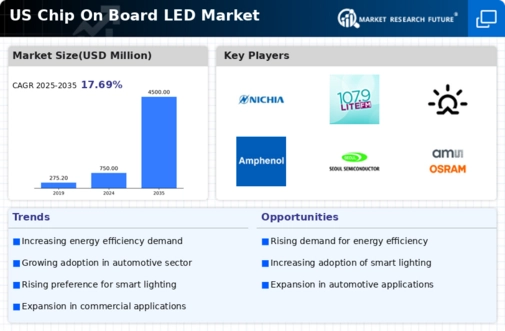Government Initiatives and Regulations
Government initiatives and regulations play a crucial role in shaping the chip on-board-led market. Various federal and state programs are promoting the adoption of energy-efficient lighting solutions through incentives and rebates. For instance, the Department of Energy has implemented standards that encourage the use of LED technology in public and private sectors. These regulations aim to reduce energy consumption and greenhouse gas emissions, thereby fostering a favorable environment for the chip on-board-led market. As compliance with these regulations becomes mandatory, manufacturers are likely to invest more in LED technology, further driving market growth.
Growth of Smart Cities and Infrastructure
The chip on-board-led market is poised for growth due to the increasing development of smart cities and infrastructure. As urban areas evolve, there is a growing emphasis on integrating smart technologies into public lighting systems. This integration not only enhances energy efficiency but also improves safety and convenience for residents. The chip on-board-led market stands to benefit from this trend, as municipalities seek to upgrade their lighting systems with advanced LED solutions. The market is expected to expand as cities invest in smart lighting that can be controlled remotely and adjusted based on real-time data, thereby optimizing energy use and reducing costs.
Rising Demand for Energy-Efficient Solutions
The chip on-board-led market is significantly influenced by the rising demand for energy-efficient lighting solutions. As energy costs continue to rise, consumers and businesses are increasingly seeking alternatives that reduce energy consumption. LED technology, known for its low power usage and long lifespan, aligns perfectly with this demand. In fact, studies indicate that LED lighting can reduce energy consumption by up to 80% compared to traditional incandescent bulbs. This shift towards energy efficiency is not only environmentally friendly but also economically advantageous, leading to substantial savings over time. Consequently, the chip on-board-led market is likely to see sustained growth as more stakeholders prioritize energy-efficient solutions.
Technological Advancements in LED Technology
The chip on-board-led market is experiencing a surge due to rapid technological advancements in LED technology. Innovations such as improved chip designs and enhanced thermal management systems are driving efficiency and performance. The integration of smart features, such as dimming and color tuning, is becoming increasingly prevalent. As a result, the market is projected to grow at a CAGR of approximately 15% over the next five years. This growth is fueled by the demand for high-quality lighting solutions in various applications, including residential, commercial, and industrial sectors. The chip on-board-led market is thus positioned to benefit from these advancements, as manufacturers strive to meet the evolving needs of consumers and businesses alike.
Consumer Preference for Aesthetic Lighting Solutions
The chip on-board-led market is also driven by changing consumer preferences for aesthetic lighting solutions. As consumers become more design-conscious, there is a growing demand for lighting that not only serves functional purposes but also enhances the ambiance of spaces. The versatility of chip on-board LEDs allows for creative applications in residential and commercial settings, making them a popular choice among designers and architects. This trend is likely to propel the chip on-board-led market forward, as manufacturers innovate to create visually appealing products that meet the aesthetic demands of consumers.




















Leave a Comment